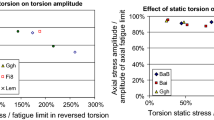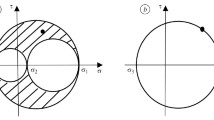Abstract
The maximum-distortion-energy ellipse is shown to be a well-defined boundary for certain high-cycle fatiguelimit data having gradient-induced scatter. In connection with this, the nonzero gradients are seen to have only a beneficial effect on fatigue behavior. The work is limited to fully reversed biaxial-stress components which are either in-phase or 180 degrees out-of-phase with each other. A means to account for anisotropy in fatigue properties is tentatively suggested.
Similar content being viewed by others
Abbreviations
- C :
-
squared ratio ofS se toS e
- D :
-
dimension, mm
- r :
-
ratio of fatigue limits,\(\bar S_{e1} \) and\(\bar S_{e2} \)
- S e :
-
fatigue limit for rotating bending of unnotched specimens, Pa or psi
- \(\bar S_e \) :
-
fully reversed, tension-compression fatigue limit of unnotched speciments with assumed isotropic fatique properties, Pa or psi
- \(\bar S_{e1} ,\bar S_{e2} \) :
-
tension-compression fatigue limits of unnotched specimens in the directions of principal anisotropy, Pa or psi
- S se :
-
fatigue limit for fully reversed torsion of unnotched specimens, Pa or psi
- σ:
-
bending stress in a combined bending and torsion test, Pa or psi
- σ xa :
-
alternating normal stress acting on the critical stress element in the x direction, Pa or psi
- σ 1a,σ2a :
-
alternating principal stresses at the critical stress element, Pa or psi
- τ:
-
shear stress in a combined bending and torsion test, Pa or psi
- τ xya :
-
alternating shearing stress acting on the x and y faces of the critical element, Pa or psi
References
Fuchs, H.O. andStevens, R.I., Metal Fatigue in Engineering, John Wiley and Sons, New York (1980).
Shigley, J.E. andMitchell, L.D., Mechanical Engineering Design, 4th Ed., McGraw-Hill, New York (1983).
Juvinall, R.C., Engineering Considerations of Stress, Strain, and Strength, McGraw-Hill, New York, 226–227 (1967).
Sawert, Walter, “Verhalten der Baustahle bei wechseinder meharchsiger Beanspruchung,”Z.V.D.I.,87 (39/40),609–615 (Oct. 1943).
Marin, Joseph, Mechanical Behavior of Engineering Materials, Prentice-Hall, Inc., Englewood Cliffs, NJ, 117–122 (1962).
Hill, R., “A Theory of the Yielding and Plastic Flow of Anisotropic Metals,”Proc. Roy. Soc., Series A,193,281–297 (1948).
Munday, E.G., Fatigue Limit Analysis Involving Biaxial Stress Components, PhD Diss., Virginia Polytechnic Institute and State Univ. (1984).
Gough, H.J., Pollard, H.V. andClenshaw, W.S., Some Experiments on the Resistance of Metals to Fatigue Under Combined Stresses, Ministry of Supply, Aero. Res. Council Reports and Memoranda, His Majesty's Stationery Office, London (1951).
Frith, P.H., “Fatigue Tests on Crankshaft Steels,”J. Iron and Steel Inst.,159,London (1948).
Nishihara, T. andKawamoto, M., “The Strength of Metals and Combined Alternating Bending and Torsion with Phase Difference,”Memoirs, College of Engineering, Kyoto Imperial Univ.,IX,85–112 (1945).
Author information
Authors and Affiliations
Rights and permissions
About this article
Cite this article
Munday, E.G., Mitchell, L.D. The maximum-distortion-energy ellipse as a biaxial fatigue criterion in view of gradient effects. Experimental Mechanics 29, 12–15 (1989). https://doi.org/10.1007/BF02327775
Received:
Accepted:
Issue Date:
DOI: https://doi.org/10.1007/BF02327775




